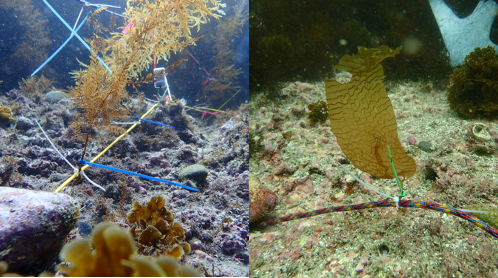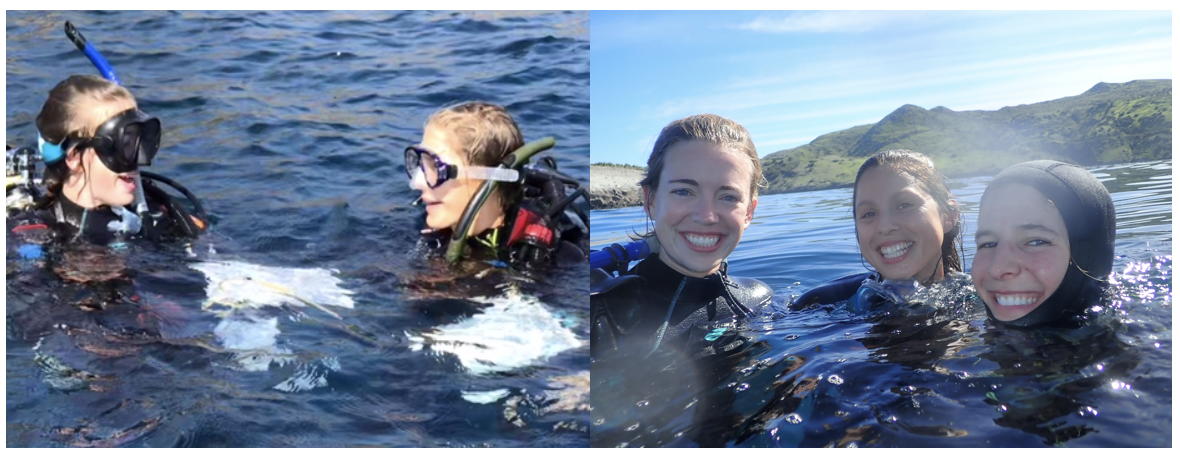By: Emily Ryznar
Hello everyone! My name is Emily and I am entering my 6th year of my Ph.D. at UCLA. I am pretty bummed to not be spending the summer at Wrigley. Nothing quite beats diving in the beautiful kelp forests, exploring the island, volunteering with visitors, and the wonderful sense of community on the island. While I would much rather be on Catalina, I am spending these COVID times analyzing and writing up data from the past two field season I collected as a Wrigley Graduate Fellow.
I study Sargassum horneri, a brown marine alga that invaded southern California in 2003 and has since spread throughout the Channel Islands, north to Point Conception, and south into Baja, Mexico. In many areas throughout its invaded range, including Catalina Island, S. horneri can form dense monocultures that have been shown to not provide the same functions as native algal species such as the giant kelp, Macrocystis pyrifera. I am generally interested in why S. horneri is successful as an invader and how it is impacting the communities it invades.

From left to right: A site dominated by Macrocystis pyrifera, a “recently disturbed” site lacking algal canopy, and a site dominated by Sargassum horneri.
One facet of my research pertains to how disturbance (or any temporary change in environmental conditions that has drastic effects on the ecosystem) and interactions with M. pyrifera influence the success of S. horneri. M. pyrifera is an important foundation species because it is capable of forming complex, underwater “forests” which in turn support over 1,000 species. Low nutrient levels and warm water temperatures associated with the climatic disturbance El Niño Southern Oscillation are generally unfavorable for M. pyrifera, which requires cold, nutrient-rich water for survival. 2014-2016 was characterized by a relatively strong El Niño, and M. pyrifera declined in many areas, including Catalina Island. This period was marked by a rapid proliferation of S. horneri with limited recovery of M. pyrifera. Therefore, it is hypothesized that declines in M. pyrifera due to El Niño released resources such as space and light that were previously unavailable to S. horneri, allowing it to rapidly increase in areas once occupied by M. pyrifera and limiting its recovery. However, this hypothesis has yet to be tested!
I sought to investigate how disturbance and interactions between M. pyrifera and S. horneri influence the invasion success of S. horneri and the recovery of M. pyrifera while at Wrigley during the winter of 2019. I conducted two experiments at Bird Rock, which at the time had a patch dominated by M. pyrifera forest, a patch dominated by S. horneri, and a “recently disturbed” patch lacking algal canopy directly adjacent to each other. To investigate how disturbance and M. pyrifera influence the success of S. horneri, I temporarily transplanted S. horneri into all three patches and monitored S. horneri growth, light, and temperature over a period of two weeks. To investigate how disturbance and S. horneri influence the recovery of M. pyrifera, I repeated the same process as the previous experiment but instead with young kelp.

From left to right: an experimental Sargassum horneri transplant and an experimental Macrocystis pyrifera transplant.
I found S. horneri grew the slowest in the M. pyrifera-dominated patch, slightly faster in the S. horneri-dominated patch, and the fastest in the bare, “recently disturbed” patch. S. horneri growth corresponded with light levels, where light was lowest in the algal-dominated patches and highest in the “recently disturbed” patch. On the other hand, M. pyrifera lost biomass regardless of whether the site was algal-dominated or bare. Taken together, these results suggest that declines in M. pyrifera due to disturbances such as El Niño can facilitate S. horneri invasion success, as S. horneri grew significantly faster in the “recently disturbed” site lacking M. pyrifera and significantly slower in the algal-dominated sites. Further, these results suggest light availability is likely influencing where S. horneri can colonize.
On the other hand, young M. pyrifera declined in biomass in every site, suggesting that removal of S. horneri may not facilitate M. pyrifera recovery following disturbance. This also suggests that factors other than light availability may be preventing M. pyrifera recovery. One possibility limiting M. pyrifera growth is herbivore preference for M. pyrifera over S. horneri, which I investigated with a field experiment during the summer of 2019 (for results of this experiment, check out my virtual Saturday at the Lab!). Another possibility is that the environmental conditions were unfavorable for M. pyrifera growth but favorable for S. horneri, as this experiment was conducted during a warm year (for more information, check out the research of Wrigley Fellow Lauren Smith, who is investigating S. horneri growth with different temperatures).
While I can’t get out to Catalina, I enjoy reflecting on all of the research I was able to accomplish and the wonderful memories that would not be possible without the support of the Wrigley Graduate Fellowship and the Wrigley community!

